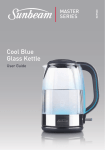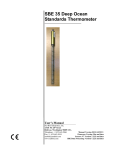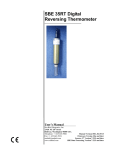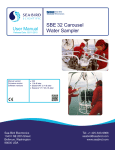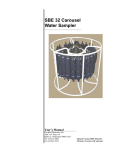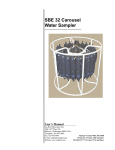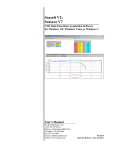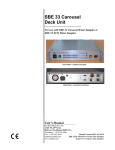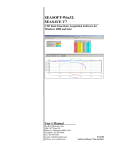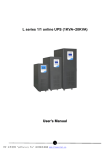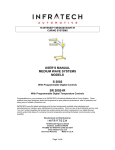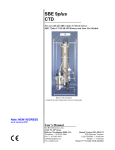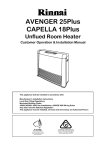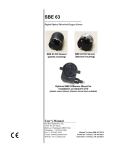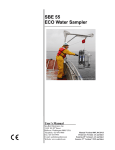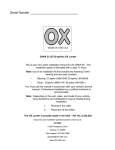Download The Cruise — Before, During, and After
Transcript
Module 16 The Cruise – Before, During, and After 2 Module 16: The Cruise – Before, During, and After Overview Module 16: The Cruise – Before, During, and After Pre-Cruise Equipment Checks 3 4 Module 16: The Cruise – Before, During, and After Pre-Cruise Equipment Checks We’ll discuss these in more detail in the next few slides. These checks are directed mostly toward equipment that is typically only used a few times a year. Equipment that is used in regular weekly/monthly sampling may not need to be checked as thoroughly before each use. Module 16: The Cruise – Before, During, and After Pre-Cruise Equipment Checks -- Connectors Application Note 57: Connector Care and Cable Installation on our website is a good resource for connector cleaning and installation, and also provides cold weather installation tips. 5 6 Module 16: The Cruise – Before, During, and After Pre-Cruise Equipment Checks – Cables and Dummy Plugs Cables can be damaged by chaffing, extreme bends, or contact with the ship deck or hull (pinching). Module 16: The Cruise – Before, During, and After Pre-Cruise Equipment Checks – Cables and Dummy Plugs Do not use WD-40 or other petroleum-based lubricants; petroleum-based lubricants will damage connectors. Dow Corning® DC-4 is a silicone-based electrical insulating compound. Other lubricants may have a tendency to ball when cold. 7 8 Module 16: The Cruise – Before, During, and After Pre-Cruise Equipment Checks – Cables and Dummy Plugs Align the dimple on the connector boot with the large pin on the connector. Remember to burp the connector(s) after installation. In cold weather, a connector may be hard to install and remove. When possible, mate connectors in warm environments before the cruise and leave them connected. If not, warm the connector sufficiently so it is flexible. To remove a frozen connector: 1. Wrap the connector with a washrag or other cloth. 2. Pour hot water on the cloth and let the connector sit for a minute or two. The connector should thaw and become flexible enough to be removed. Module 16: The Cruise – Before, During, and After Pre-Cruise Equipment Checks – External Hardware Excess corrosion on anodes can negate their effectiveness. Rapid loss of anode material can be an indication of grounding problems. Always install Teflon insulating tape on mounting straps. Pay particular attention to the buckle on the mounting strap. 9 10 Module 16: The Cruise – Before, During, and After Pre-Cruise Equipment Checks – Inductive Instruments Proper communications with an IM instrument requires that the ferrites are not damaged, and that the two modem halves mate closely (< 0.1 mm gap). Note that if the clamp inserts are too small for the cable, there will be a gap between the modem halves. An attempt to reduce the gap may damage the cable or modem if the bolts are over-tightened. Application Note 85: Handling of Ferrite Core on Instruments with Inductive Modem Telemetry provides details. Module 16: The Cruise – Before, During, and After Pre-Cruise Equipment Checks – Plumbing Contaminated plumbing may degrade the initial data. New instruments include several pieces of wire for clearing the air bleed hole. Conductivity cells are glass and can be damaged by impact or mishandling. • Cells with chipped ends are usually OK to use. • Larger cracks or breaks in the cell will cause bad data and may allow the instrument to flood. 11 12 Module 16: The Cruise – Before, During, and After Pre-Cruise Equipment Checks – Pressure Capillary Sea-Bird can provide a pressure sensor oil refill kit, PN 50025, for these instruments. Application Note 12-1: Pressure Port Oil Refill Procedure & Nylon Capillary Fitting Replacement provides the details on use of the kit. Note: Instruments with Druck strain gauge pressure use a pressure port plug instead of a pressure capillary; oil filling is not required. These instruments include: SBE 16plus, 16plus-IM, 16plus V2, 16plus-IM V2 with strain gauge pressure sensor; 19plus and 19plus V2, 25plus, 37, 39, 49, and 52-MP. The SBE 26, 26plus, 53, and 54 have a pressure capillary connected to a bladder bag, which is filled with silicone oil at the factory. See the applicable user manual for details. Module 16: The Cruise – Before, During, and After 13 Pre-Cruise Equipment Checks – Batteries Batteries may have a good voltage reading when not under load. Always make sure that the battery end cap and the cage above the battery end cap are completely dry before opening the battery end cap. This will prevent water from dripping into the battery compartment. 14 Module 16: The Cruise – Before, During, and After Pre-Cruise Equipment Checks – Verify Functionality As applicable, capture and save responses to status commands (DS – display status, DC – display calibration coefficients, etc.). This will help to verify the instrument setup if troubleshooting is required later. Module 16: The Cruise – Before, During, and After 15 Pre-Cruise Equipment Checks – Verify Functionality As mentioned on the last slide for the status commands, saving this data will help to verify the instrument was functioning properly before the deployment if troubleshooting is required later. If the testing is performed in air, put a few drops of water in the pump head to lubricate the pump impeller. 16 Module 16: The Cruise – Before, During, and After Shipping Precautions If shipping by air: • Lithium batteries cannot be shipped installed in MicroCATs or SBE 44s. • D-cell lithium batteries cannot be shipped installed in the instrument. • NiMH battery packs cannot be shipping installed in the instrument. We’ll cover this in more detail in Module 18. Taping the magnetic switch will prevent the instrument from being turned on accidentally during transit. If spare parts are being shipped in the crate, make sure they are adequately secured. Module 16: The Cruise – Before, During, and After Moored Instruments and Anti-Foul Paint 17 18 Module 16: The Cruise – Before, During, and After Tools and Spare Parts Some spares are not practical as their use requires recalibration of the instrument (for example, spare conductivity cells and spare temperature probes). Module 16: The Cruise – Before, During, and After Tools and Spare Parts If weight is a factor, create a custom tool box with only tools that fit the hardware installed on your instrument. A crescent wrench is useful for opening the battery end cap. The Multimeter can be a valuable diagnostic tool. 19 20 Module 16: The Cruise – Before, During, and After Tools and Spare Parts When it comes to spares, having more is usually better! Work within your comfort zone when deciding what you need as spares. The best Spare is a backup system. Module 16: The Cruise – Before, During, and After 21 Tools and Spare Parts Having pre-mixed solutions is a timesaver. Use bottled DI water for flushing cells and sensors. The ship’s fresh water supplies may contain trace contaminants. 22 Module 16: The Cruise – Before, During, and After Care and Maintenance during Cruise Rough weather can create hazards. Exhausts may contain traces of oils and other contaminants. UV can shorten the life of plastics as well as promote growth of bio-fouling. Module 16: The Cruise – Before, During, and After Care and Maintenance during Cruise Use a 0.1% Triton X-100 solution to rewet the conductivity cell. Soaker tubes and par covers inadvertently left in place can cause severe damage. A check list is especially helpful if personnel unfamiliar with the system are assisting (Students, Grad Students, Ship’s Tech, etc.). 23 24 Module 16: The Cruise – Before, During, and After Care and Maintenance during Cruise Most ships have both freshwater and saltwater wash-down hose connections. Make sure you are using the freshwater. Module 16: The Cruise – Before, During, and After 25 Care and Maintenance of Water Samplers The titanium parts of the trigger are coated in Tiodizing (similar to anodizing aluminum). 26 Module 16: The Cruise – Before, During, and After Flooded Instruments Loosening the end cap hardware to test if the instrument is under pressure is only applicable to instruments that attach to the housing through the top of the end cap (for example, SBE 9plus, 25, 17plus, 26, 26plus, 53, 54). Loosening the end cap hardware to test if the instrument is under pressure is not applicable to instruments with end caps that attach to the housing through the side instead of the top of the end cap (for example, SBE 16plus and 16plus V2, 16plus-IM and 16plus-IM V2, 19plus and 19plus V2, 25plus, 37, 49). See your instrument manual for detailed instructions on handling flooded instruments. Module 16: The Cruise – Before, During, and After Flooded Instruments Some instruments do not have connectors Use extreme caution when handling these instruments. 27 28 Module 16: The Cruise – Before, During, and After Flooded Instruments Any details that you can provide to Sea-Bird regarding a flooded instrument are appreciated, especially deployment depth or the depth that good data was lost (modular or real time sensors). Module 16: The Cruise – Before, During, and After 29 Care and Maintenance after Cruise Post-cruise maintenance is very important to the longevity of the instrument. Trapped salt water will form crystals as it dries; these crystals can eventually cause damage to both housings and O-rings. 30 Module 16: The Cruise – Before, During, and After Care and Maintenance after Moored Instrument Recovery You need to remove as much biological material from the outside of the housing as possible. Sea-Bird cannot place an instrument with a large amount of biological material on the housing in our calibration bath. Plug the ends of the conductivity cell to prevent the cleaning solution from getting into the cell, and then soak the entire instrument in white vinegar for a few minutes. We recommend using a Heavy Duty Scotch-Brite pad (http://www.3m.com/us/home_leisure/scotchbrite/products/scrubbing_scouring.html) or similar scrubbing device. When using vinegar on instruments with epoxy cast cells (SBE 4, 16, 19, and 21), avoid prolonged contact of the cell with the vinegar as it may damage the RTV on the cell. If you painted the housing with anti-foul paint, you will need to remove this as well, using a Heavy Duty Scotch-Brite pad. Module 16: The Cruise – Before, During, and After Storing Instruments after Recovery If batteries leak in the battery compartment, battery bulkhead replacement needs to be performed at Sea-Bird. 31
































